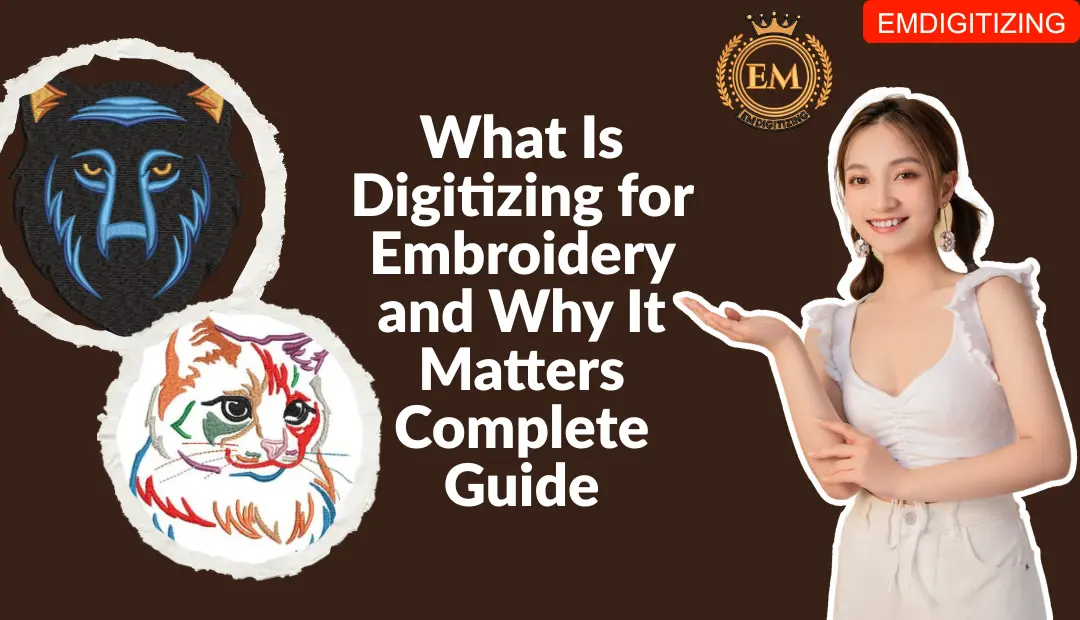In 2025, embroidery digitizing and vector art are essential tools for designers, small businesses, and hobbyists creating custom designs, yet they serve distinct purposes in the creative process. While vector art provides scalable, digital artwork for logos or graphics, embroidery digitizing transforms those designs into stitch files for machine embroidery. Understanding their differences is crucial for choosing the right approach for your project, whether branding apparel or crafting personalized gifts. This blog explores the key differences between vector art and embroidery digitizing, detailing their purposes, processes, and applications, while driving traffic to your design projects. Explore professional solutions at Emdigitizing’s portfolio.
What Are Vector Art and Embroidery Digitizing?
Vector Art
Vector art is a digital graphic created using mathematical paths (lines, curves) in software like Adobe Illustrator or Inkscape. Stored in formats like SVG, AI, or EPS, vector art is scalable without losing quality, making it ideal for logos, icons, or print designs. It’s widely used across industries for its versatility and precision.
-
Key Features: Scalable, editable, used for digital or print media.
-
Common Uses: Business logos, posters, or website graphics.
Embroidery Digitizing
Embroidery digitizing converts artwork into machine-readable stitch files (e.g., DST, PES, JEF) that guide embroidery machines to sew designs onto fabrics like cotton, denim, or polyester. It involves specifying stitch types (satin, fill), colors, and paths, ensuring durability and clarity for embroidered items.
-
Key Features: Fabric-specific, machine-focused, used for physical embroidery.
-
Common Uses: Logos on uniforms, monograms on bags, or patterns on apparel.
While vector art is often a starting point for digitizing, the two processes differ significantly in purpose, output, and complexity. Let’s break down their differences.
Key Differences Between Vector Art and Embroidery Digitizing
1. Purpose and Output
-
Vector Art: Creates digital graphics for versatile applications, such as logos, signage, or digital displays. The output is a scalable file (SVG, AI) used for visual or printed designs.
-
Embroidery Digitizing: Produces stitch files for embroidery machines to sew designs onto fabric. The output is a machine-specific file (DST, PES) tailored for physical embroidery.
Example: A small business creates a vector logo in Inkscape for its website, then digitizes it for embroidered staff shirts, requiring two distinct processes.web:1
2. File Formats
-
Vector Art: Uses formats like SVG, AI, EPS, or PDF, which store mathematical paths for scalability. These are compatible with design software or print systems.
-
Embroidery Digitizing: Uses formats like DST, PES, JEF, or EXP, which contain stitch instructions (e.g., coordinates, stitch types) for embroidery machines. These are not directly editable in standard design software.
Example: A designer saves a logo as SVG for posters, but converts it to PES for embroidering caps, using embroidery digitizing services for accuracy.web:2
3. Design Complexity
-
Vector Art: Supports intricate details, gradients, and unlimited colors, as it’s designed for visual clarity on screens or print. Fine lines or complex shapes are easily handled.
-
Embroidery Digitizing: Requires simplified designs (3–6 colors, no gradients) due to embroidery machine limitations. Small details (under 0.25 inches) may blur, and stitch types must suit fabric.
Example: A boutique’s vector logo with gradients works for flyers but needs simplification for digitizing, removing gradients for clear embroidery on tote bags.web:3
4. Process and Tools
-
Vector Art: Created in software like Adobe Illustrator, CorelDRAW, or Inkscape, focusing on shapes, paths, and colors. The process emphasizes visual aesthetics and scalability.
-
Embroidery Digitizing: Requires specialized software like Hatch Embroidery, SewArt, or Ink/Stitch to map stitches, set density (0.4–0.6 mm), and add underlay for fabric stability. The process prioritizes machine compatibility and fabric suitability.
Example: A freelancer uses Illustrator to design a logo, then Hatch Embroidery to digitize it for denim jackets, adjusting stitch density for durability.web:4
5. Application Medium
-
Vector Art: Used for digital (websites, social media) or print (business cards, banners) media, where resolution and scalability are key.
-
Embroidery Digitizing: Applied to physical fabrics (apparel, hats, bags) via embroidery machines, where stitch quality and fabric interaction matter.
Example: A startup uses a vector logo for its website banner, but digitizes it for embroidered uniforms to maintain a professional image at events.web:5
6. Skill Level and Time
-
Vector Art: Requires moderate design skills, learnable in 5–20 hours using tutorials for Illustrator or Inkscape. Creating a logo takes 1–3 hours.
-
Embroidery Digitizing: Demands additional knowledge of stitch types, fabric behavior, and machine settings, with a steeper learning curve (10–30 hours). Digitizing a design takes 1–4 hours for beginners.
Example: A hobbyist designs a vector monogram in 2 hours but spends 3 hours digitizing it, learning stitch settings for cotton fabric.web:6
Comparison Table: Vector Art vs. Embroidery Digitizing
|
Aspect |
Vector Art |
Embroidery Digitizing |
|---|---|---|
|
Purpose |
Digital/print graphics |
Stitch files for fabric embroidery |
|
File Formats |
SVG, AI, EPS, PDF |
DST, PES, JEF, EXP |
|
Design Complexity |
Supports gradients, fine details |
Simplified, 3–6 colors, no gradients |
|
Tools |
Illustrator, Inkscape, CorelDRAW |
Hatch, SewArt, Ink/Stitch |
|
Medium |
Digital, print |
Fabric (cotton, denim, polyester) |
|
Skill/Time |
Moderate, 1–3 hours per design |
Advanced, 1–4 hours per design |
|
Cost |
Free–$100 (software) |
Free–$150 (software) or $10–$50 (service) |
Example: A retailer uses this table to decide between vector art for flyers and digitizing for branded aprons, choosing Emdigitizing for the latter.web:7
How to Use Vector Art and Embroidery Digitizing Together
Vector art and embroidery digitizing often work hand-in-hand, with vector art serving as the foundation for digitizing. Here’s how to integrate them effectively:
Step 1: Create Vector Art
Design your artwork in vector format:
-
Software: Use Inkscape (free) or Adobe Illustrator.
-
Specifications: Ensure 300 DPI or vector paths, 3–6 colors, and no tiny details (under 0.25 inches).
-
Save: Export as SVG or AI for digitizing compatibility.
Example: A small business designs a logo in Inkscape, saving it as SVG for both print and embroidery use.web:8
Step 2: Prepare for Digitizing
Simplify the vector art for embroidery:
-
Remove Gradients: Replace with solid colors.
-
Adjust Details: Enlarge small text or shapes (above 0.25 inches).
-
Check Colors: Limit to 3–6 thread colors (e.g., Madeira, Isacord).
Example: A designer simplifies a vector logo’s fine lines for embroidery, ensuring clarity on staff shirts.web:9
Step 3: Digitize the Artwork
Convert the vector art into a stitch file:
-
DIY: Use Ink/Stitch or SewArt to set satin stitches (outlines), fill stitches (areas), density (0.4–0.6 mm), and underlay.
-
Outsourced: Send the vector file to a service, specifying fabric (cotton, denim) and machine format (PES, DST).
-
Preview: Use digital or AR previews to check stitch quality.
Example: A boutique outsources its vector logo to a service for digitizing, receiving a PES file for polyester caps.web:10
Step 4: Test and Embroider
Test the stitch file and embroider:
-
Test: Sew on scrap fabric to check for puckering or thread breaks.
-
Revise: Adjust density or underlay if needed.
-
Embroider: Hoop final fabric, run the machine, and trim threads.
Example: A retailer tests a digitized logo on scrap denim, fixing a thread break before embroidering 50 bags.web:11
Step 5: Use Vector Art for Other Needs
Repurpose the vector art for non-embroidery applications:
-
Digital: Add to websites, social media, or email signatures.
-
Print: Use for business cards, flyers, or banners.
-
Promote: Share designs online to boost brand visibility.
Example: A startup uses its vector logo for Instagram posts and digitizes it for event shirts, maximizing brand exposure.web:12
Applications for Small Businesses, Designers, and Hobbyists
Small Businesses
Use vector art for digital branding and digitizing for embroidered uniforms or merchandise.
Designers
Create vector art for client logos, then digitize for apparel or accessory collections.
Hobbyists
Design vector monograms for personal use, digitizing them for gifts or Etsy products.
Best Practices for Vector Art and Embroidery Digitizing
To optimize both processes:
-
Start with Vectors: Create scalable SVG or AI files for versatility.
-
Simplify for Embroidery: Limit colors and details in vector art for digitizing.
-
Use Quality Tools: Choose Illustrator for vectors, Hatch or Emdigitizing for digitizing.
-
Test Stitch Files: Sew samples to catch errors before final embroidery.
-
Match Fabrics: Adjust stitch settings (density 0.4–0.6 mm) for cotton or polyester.
-
Leverage Services: Outsource complex digitizing to save time.
-
Promote Designs: Share vector and embroidered creations on social media or forums.
These practices ensure high-quality results across digital and embroidered outputs.
Emerging Trends in Vector Art and Digitizing
-
AI-Driven Design: AI tools simplify vector creation and stitch mapping, reducing errors.
-
Sustainable Practices: Eco-friendly threads and optimized files align with green trends.
-
AR Visualization: Preview vector designs or stitch files on fabric via augmented reality.
-
Cross-Platform Integration: Software like Ink/Stitch bridges vector and digitizing workflows.
Example: A designer uses AI tools to create a vector logo and digitize it for eco-friendly totes, previewing with AR for accuracy.web:13
Conclusion
Understanding the differences between vector art and embroidery digitizing is essential for designers, small businesses, and hobbyists aiming to create impactful designs in 2025. Vector art offers scalable, versatile graphics for digital or print media, while embroidery digitizing delivers stitch files for durable, fabric-based designs. By using vector art as a foundation and digitizing for embroidery, you can achieve professional results across applications. Leverage embroidery digitizing services like Emdigitizing, follow best practices, and embrace trends like AI and AR to elevate your projects. Share your creations to inspire others and grow your design journey.
FAQs
Q: What’s the main difference between vector art and embroidery digitizing?
Vector art creates digital graphics; digitizing produces stitch files for embroidery.
Q: Can vector art be used directly for embroidery?
No, it must be digitized into a stitch file (DST, PES) for embroidery machines.
Q: What file formats are used for vector art vs. digitizing?
Vector art uses SVG, AI; digitizing uses DST, PES, or JEF for machines.
Q: Is digitizing harder than creating vector art?
Yes, digitizing requires knowledge of stitches and fabrics, beyond vector design skills.
Q: When should I outsource digitizing?
For complex designs, tight deadlines, or fabrics needing expertise, outsourcing is best.


